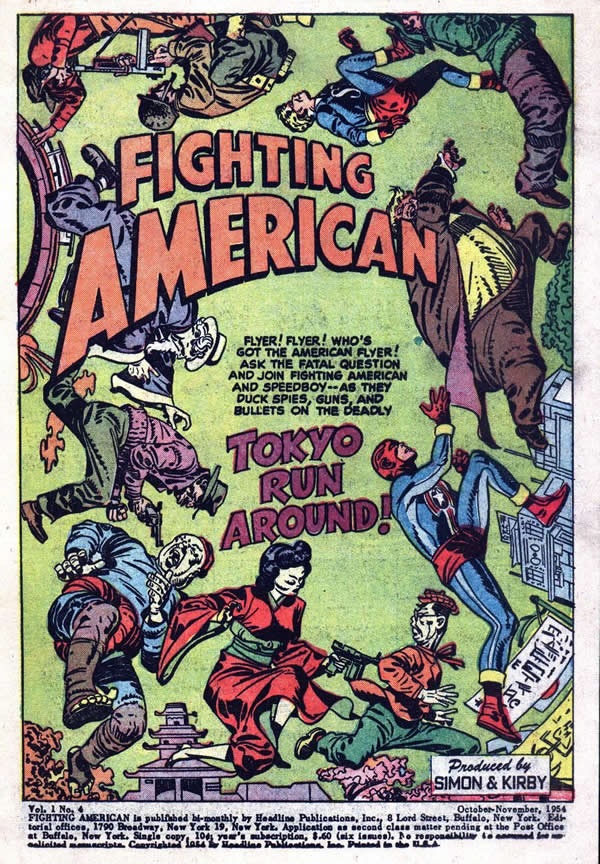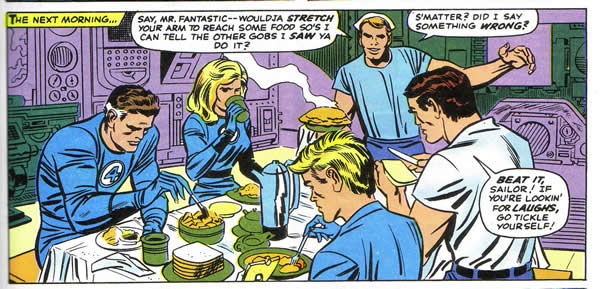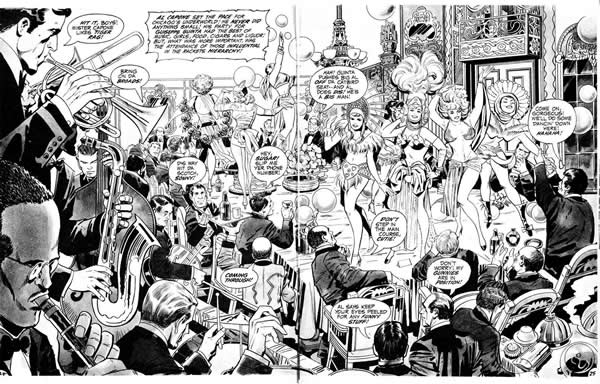One of the most interesting aspects of sequential storytelling is the depiction of the passage of time. This most commonly takes place with the progression of panels, but also can function in the compositional structure of an individual panel. In his excellent article “That Old Jack Magic,” first published in Amazing Heroes 100 (1986) and now offered on the Kirby Museum website, Kirby scholar and biographer, Greg Theakston draws attention to a compositional tool that Kirby used to great effect. Theakston refers to it as the Big O, because its function is to lock our eyes into a circular pattern moving around the page. In showing an example of this, allow me to start with this obvious choice, a splash panel from Fighting American #4
In this particular case, Kirby actually has the characters running in a circle around the border of the page. Were it not for the words Fighting American and Tokyo Runaround, the eye would not rest on any of the figures, but continue to circle. As it is, because of the lettering and several other devices Kirby uses, the hero’s figure is the most prominent.
I point this out because it is the progression and position of figures that creates the illusion of time as well as space. Because the lettering and several gestures lead the eye to Fighting American, he is the set off point for the run around which takes place in virtual panel time. This idea can take on greater levels of complexity depending on the composition. In this panel from Fantastic Four #39, a conversation is taking place around a table.
The reader’s eye enters the page with the visual cue of the yellow box reading, “the Next morning” and then on to the word balloon emanating from the sailor and finally comes to rest on the sailor himself. However, this is not the only cue to follow, as the structure of the entire composition will also lead us to the sailor. He is the apex of a pyramid that begins with the figure of Mr. Fantastic, travels rightward past Sue Storm to the top of the sailor’s head, down his arm to Ben Grimm’s shoulder and around left again to Johnny Storm. The oval shape moves the eye around, but the progression of a few moments in time must begin with Mr. Fantastic and end with Ben Grimm’s words. This is a clear sequence of time in comic storytelling.
Let us next dwell on this incredibly complex scene from In the Days of the Mob, where the tableaux gives us a panoramic view of a lavish gangland party.
The sequence of time follows the order of the spoken dialog, opening with the trumpet player on the upper left, where the eye is accustomed to beginning. However, the upward trajectory of the slide trombone points to the expository box beginning with the words Al Capone, which we read next, followed by the “Bring on the Broads” balloon. We then follow the trumpet’s shape to the second speaker, also indicated by the curve of the saxophone. We continue to move down to the edge of the banquet table in a circular motion. We pick up each speaker in turn as the eye sweeps to the right and up and around to the dancing girls on top of the table. Finally, the eye comes to rest on a tiny figure in the center of the page that is at the end of the conga line of girls, speaking the words, “Hah! Guinta pushes Big Al off the Catbird seat.”
To look at this panel is to engage in a very complex interaction with the reading process. The events in this tableaux are not taking place simultaneously. It is perceived and read in the sequence that Kirby desires it to be taken in. The composition creates the illusion of the passage of time. This, to me is one of the most amazing examples of displaying what sequential art is capable of. The depiction of time in the telling of a story was yet another aspect of Kirby’s work that showcased his mastery of the comics medium.
1 – Fighting American #4, Joe Simon and Jack Kirby.
2 – Fantastic Four #39, Stan Lee and Jack Kirby.
3 – In the Days if the Mob, “Al Capone,” story and art by Jack Kirby.




